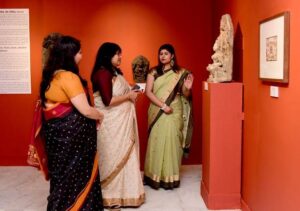WOMEN’S DAY National Museum exhibition explores role of women in India’s millenia

Team L&M
A special exhibition to mark the International Women’s Day Power, Patronage, and Piety – Celebrating Womanhood began yesterday at the National Museum in Delhi. It was inaugurated by Joint Secretary of Ministry of Culture, Government of India Lily Pandeya in the presence of National Museum Director General Partha Sarthi Sen Sharma.
This show focuses on examining the traditional notions of power, patronage, and piety – three constructs have often been associated with masculinity – through the lens of feminity. It presents the fundamental and prominent role women have played throughout India’s millennia.
The exhibition presents transcultural notions of Indian art and history representing ‘the female voice’. Spanning across different religious and social representations, it focuses on the iconic representations of women in India through sculptures, manuscripts, miniatures, jewellery, tapestries, ritual objects and amulets, as bearers of a unique visual and material culture.
The exhibition traces the feminine power through the goddess cult and the female pantheon by examining texts and rituals, folk practices based on fertility rituals, and the manifestations of wisdom through divinities in Indic traditions. Patronage is explored via the literary texts and art commissioned by Queens and Princesses.
The exhibition concludes with piety, both towards filial relations and religious discourses, through the feminine devotional practices. The objects collectively bring forth a historical narrative that has been part of an Indian consciousness for centuries.
With about 100 objects on display, the exhibition highlights masterpieces from the collections of Pre-History, Archaeology, Manuscript, Anthropology, Decorative Art, Central Asian Antiquities, Pre-Columbian and Western Art, Painting, Numismatics, Epigraphy and Jewellery, and Arms and Armour.
Beginning with the famous Dancing Girl and Mother Goddess from the Indus Valley Civilisation and proceeding onward to the Classical and Medieval goddess cults in Hindu, Jain, and Buddhist traditions, the representation of Devi and Shakti is a common strand connecting such distinctive traditions.
Royal power and patronage is represented by medieval art, commissioned by the female members of regal courts and families. Representations of women are also visible in pre-modern folk practices through pattachitras, warli painting, and matani pachedi among others.
Aspects of power, patronage, and piety from ancient to modern times are highlighted in the exhibition, presenting the fundamental and prominent role women have played throughout India’s millennia.
The exhibition will remain open for public till April 8



